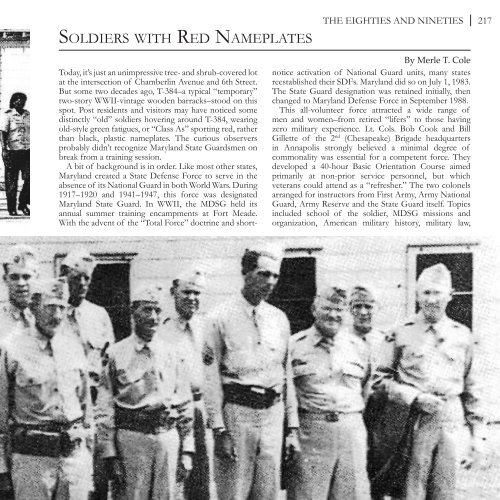Fort George G. Meade: The First 100 Years
You may know Fort George G. Meade as a cyber and intelligence hub, but did you know that the installation used to be the home of Army Tank School after World War I? Or that it housed an internment camp at the start of World War II for primarily German-American and Italian-American citizens and foreign nationals? Learn more about the fascinating history of the third largest Army base in the U.S. in terms of number of workforce in this book.
You may know Fort George G. Meade as a cyber and intelligence hub, but did you know that the installation used to be the home of Army Tank School after World War I? Or that it housed an internment camp at the start of World War II for primarily German-American and Italian-American citizens and foreign nationals? Learn more about the fascinating history of the third largest Army base in the U.S. in terms of number of workforce in this book.
You also want an ePaper? Increase the reach of your titles
YUMPU automatically turns print PDFs into web optimized ePapers that Google loves.
Soldiers with Red Nameplates<br />
THE EIGHTIES AND NINETIES<br />
217<br />
Today, it’s just an unimpressive tree- and shrub-covered lot<br />
at the intersection of Chamberlin Avenue and 6th Street.<br />
But some two decades ago, T-384–a typical “temporary”<br />
two-story WWII-vintage wooden barracks–stood on this<br />
spot. Post residents and visitors may have noticed some<br />
distinctly “old” soldiers hovering around T-384, wearing<br />
old-style green fatigues, or “Class As” sporting red, rather<br />
than black, plastic nameplates. <strong>The</strong> curious observers<br />
probably didn’t recognize Maryland State Guardsmen on<br />
break from a training session.<br />
A bit of background is in order. Like most other states,<br />
Maryland created a State Defense Force to serve in the<br />
absence of its National Guard in both World Wars. During<br />
1917–1920 and 1941–1947, this force was designated<br />
Maryland State Guard. In WWII, the MDSG held its<br />
annual summer training encampments at <strong>Fort</strong> <strong>Meade</strong>.<br />
With the advent of the “Total Force” doctrine and short-<br />
By Merle T. Cole<br />
notice activation of National Guard units, many states<br />
reestablished their SDFs. Maryland did so on July 1, 1983.<br />
<strong>The</strong> State Guard designation was retained initially, then<br />
changed to Maryland Defense Force in September 1988.<br />
This all-volunteer force attracted a wide range of<br />
men and women–from retired “lifers” to those having<br />
zero military experience. Lt. Cols. Bob Cook and Bill<br />
Gillette of the 2 nd (Chesapeake) Brigade headquarters<br />
in Annapolis strongly believed a minimal degree of<br />
commonality was essential for a competent force. <strong>The</strong>y<br />
developed a 40-hour Basic Orientation Course aimed<br />
primarily at non-prior service personnel, but which<br />
veterans could attend as a “refresher.” <strong>The</strong> two colonels<br />
arranged for instructors from <strong>First</strong> Army, Army National<br />
Guard, Army Reserve and the State Guard itself. Topics<br />
included school of the soldier, MDSG missions and<br />
organization, American military history, military law,


